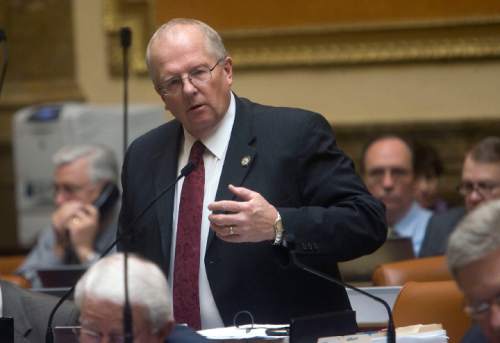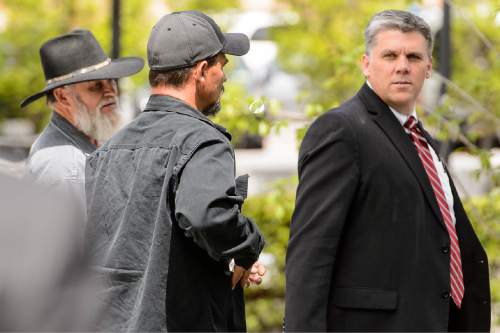This is an archived article that was published on sltrib.com in 2015, and information in the article may be outdated. It is provided only for personal research purposes and may not be reprinted.
A federal report has documented about $400,000 in damage to Utah's Recapture Canyon after an anti-government protest ride last spring.
And San Juan County Commissioner Phil Lyman could be on the hook for that tab when he is sentenced next month for his role in leading the protest.
That's according to state Rep. Mike Noel, R-Kanab, who believes federal prosecutors will try to impose that sum as restitution.
During Tuesday's meeting of the Utah Commission for the Stewardship of Public Lands, Noel blasted the Bureau of Land Management's damage report as "preposterously inflated and a blatant lie" and said the U.S. Justice Department is "completely out of control."
Noel cited the report, which has not been publicly released, to persuade the commission to support a resolution — with a party-line vote — declaring a "public interest" in Lyman's legal predicament.
The resolution is a prelude to Noel's stated plan to persuade the Utah Constitutional Defense Council to invest up to $100,000 in state funds to help pay for Lyman's legal defense and likely appeal.
Lyman was convicted in May along with blogger and Monticello City Councilman Monte Wells of conspiracy for their efforts to organize and publicize the May 2014 ride. Protesters on ATVs allegedly drove over archaeological resources along the floor of the scenic canyon just east of Blanding.
Noel argues all state residents have a stake in the outcome of Lyman's case. The federal charges, he said, "will have a chilling effect on other county commissioners and sheriffs to exercise their duty to protect the health, safety and welfare of the citizens in their jurisdiction," Noel said.
The Kanab lawmaker himself organized a protest ride in 2009 up Paria Canyon, which is a wilderness study area and closed to motorized use. He was never charged.
The public land commission was formed last year to help advance the state's goal of taking title to 30 million acres of public land.
"There is a strong connection between the transfer of public land and the actions occurring in San Juan County by federal agencies to shut down the use of these public lands," Noel said.
The panel's two Democrats both refused to endorse Noel's resolution — which they consider legislative overreach — on Tuesday.
"We have a process. We have a legal system," said Salt Lake City Sen. Jim Dabakis. "Eventually and hopefully, justice prevails. For this committee to get involved in a clearly judicial proceeding … is completely inappropriate.
He added: "If you want to protest, fine. Do the time, or go through the process and have enough faith that the truth is going to come out."
Noel says Lyman's legal tab has already exceeded $35,000 and will balloon as he takes his case to the 10th Circuit Court of Appeals.
Dabakis and Rep. Joel Briscoe, also of Salt Lake City, argue Lyman's supporters, not the public, should come to the embattled commissioner's financial rescue.
"There are numerous private groups who believe in these causes," Briscoe said. "If this is a case that defends states' rights, there ought to be plenty of libertarian think tanks with deep pockets that ought to be able to pony up $100,000.
"I object to spending tax dollars picking a winner or loser in this case."
Two other protest riders were acquitted. Unlike Lyman, his co-defendants have court-appointed attorneys.
U.S. District Court Judge Robert Shelby will sentence the men July 15 in Salt Lake City, where they face up to one year in jail and $100,000 in fines for the misdemeanor convictions.
Restitution will likely be the subject of a separate evidentiary hearing. The key point of contention will be the valuation of damages protest riders caused by motoring a trail BLM closed in 2007 after officials determined unauthorized trail construction damaged archaeological sites and may have facilitated looting.
Noel claims the BLM's damage assessment was flawed because it was conducted two weeks after the protest ride and studied sites three miles from where Lyman directed protesters to ride.
"For prosecutors to seek retribution for pretended harm is vindictive," Noel said.
Federal officials declined to comment on Noel's criticism, except to say no decisions have been made about how much restitution prosecutors will seek.
"This will be a litigated aspect of the case. It won't be up to us. It will be up to the judge," said Melodie Rydalch, a spokeswoman for the U.S. Attorney's Office. "Throwing numbers around at this point will confuse and worry people."
Juan Palma, who recently retired as head of BLM's state office, defended the assessment as the thorough and accurate work of an out-of-state contractor.
"We went with a third party so no one would say later, 'It's just a BLM report,'" said Palma. "We wanted to make sure there were no innuendos later that the BLM made this stuff up."
Meanwhile, Noel disputes whether Lyman received a fair trial because Shelby refused to allow testimony about how Recapture Trail was historically used and allegations that the BLM closed it illegally.
Noel and others have argued Recapture once functioned as a highway through southeastern Utah and federal land managers illegally closed it to motorized use. However, San Juan County has yet to assert a claim under RS2477 to a route through the canyon, much of which is too rugged to support normal vehicle travel.
Even if Lyman's ride broke the law, Noel says, it is the type of offense that is normally punished with a $250 fine.
"All protesters were encouraged to stay on the county pipeline road," he said. "Ninety-nine percent of the people did. Only the people who drove on the road were charged."
At the pre-ride rally, Lyman did ask protesters to stick to a pipeline service road. His lawyers argued at trial that he had permission to drive the road from the water district, which holds an easement to service the pipe. He turned around at the end of the pipeline, but many continued into an area the BLM says is rich with remnants of a Native American culture that inhabited the canyon 1,000 years ago.
Contrary to Noel's account, prosecutors put on evidence that several protesters rode far beyond the end of the pipeline road, exiting at Brown's Canyon, including Lyman's three co-defendants.
Because of their conspiracy convictions, Wells and Lyman could be held responsible for damages caused by those protesters.





